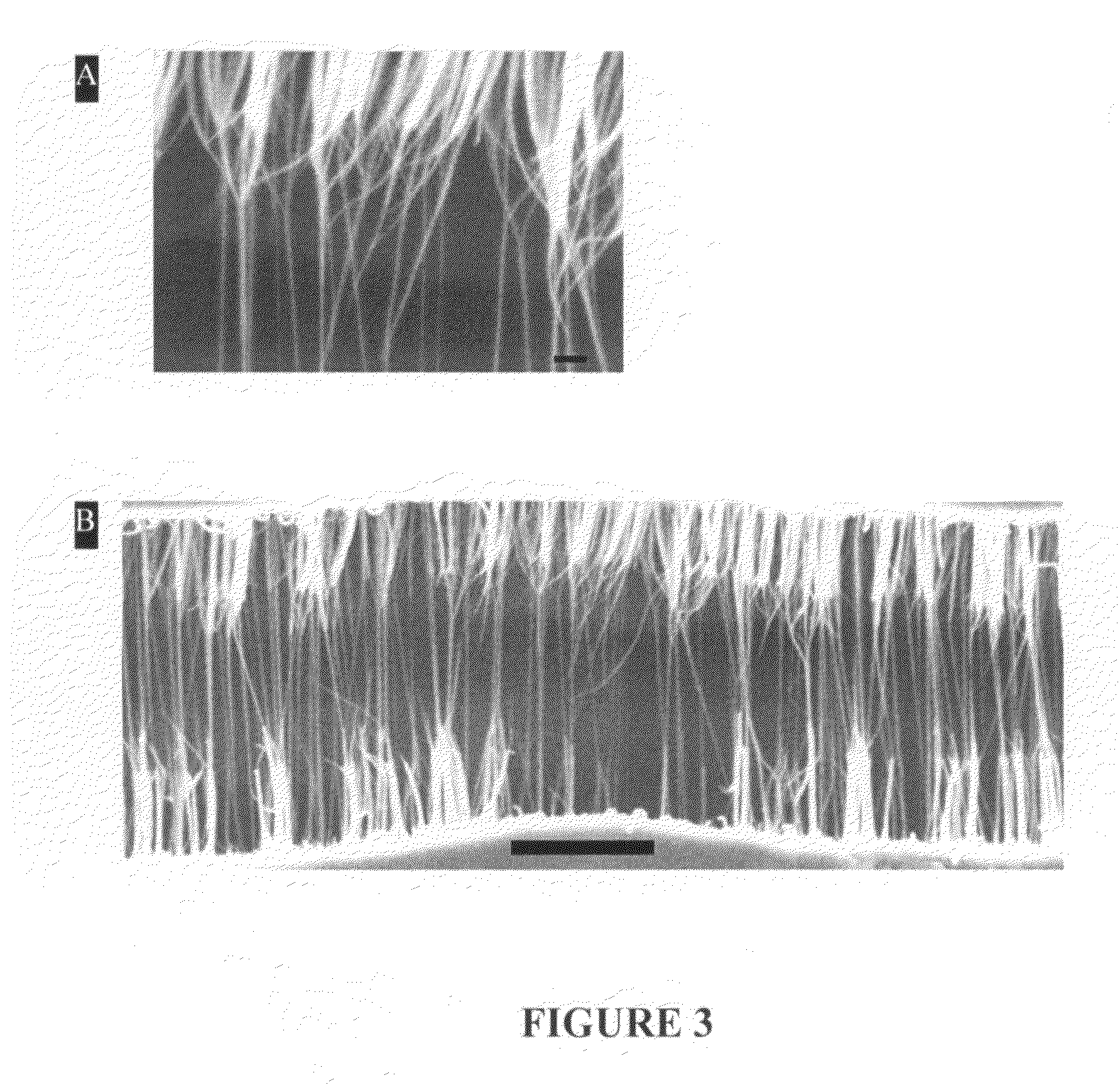Integrated biofuel cell with aligned nanotube electrodes and method of use thereof
a biofuel cell and nanotube electrode technology, applied in the direction of immobilised enzymes, diaphragms, chemical vapor deposition coatings, etc., can solve the problems of difficult access to the reaction center of these enzymes, difficult to immobilize carbon nanotube surfaces, and inability to fabricate practical biological fuels and/or biological fuel cells
- Summary
- Abstract
- Description
- Claims
- Application Information
AI Technical Summary
Problems solved by technology
Method used
Image
Examples
example 1
[0091]In one embodiment, the experiments resulting in functionalization and stable dispersion were carried out in a CEM Model 205 microwave oven with a 100 ml closed-vessel reaction chamber lined with Teflon PFA®, and connected to a 0˜200 psi pressure control system. The microwave system could be programmed to operate at different pressures, power levels and time periods. For this embodiment 200 psi pressure and 900 Watts of power were used.
[0092]In one reaction of this embodiment, 10 to 20 mg of as-received, pure SWNTs were added to 20 ml of a 1:1 mixture of 70% nitric acid and 97% sulfuric acid aqueous solutions in the reaction chamber. The microwave power was set at 50% of a total of 900 Watts, and the pressure was set at 20 psi. The reaction vessel was then subjected to microwave radiation for 1, 2, 3, 5, 10 and 20 minutes. Functionalization of the SWNTs as determined by FTIR spectroscopy and the dispersion of SWNTs were not observed when the SWNT-acid mixture was not subjected ...
example 2
[0113]In one embodiment, bimetallic cobalt (Co): molybdenum (Mo) with 1:1 or 1.6:1 in atomic weight ratio was used as catalyst / promoter for the growth of SWNTs. The catalyst / promoter precursors were deposited by dip or spin coating techniques. The dip-coating precursor was prepared by suspending and sonicating a mixture of Co and Mo acetates in chloroform containing 0.02 wt % of metals to total solution. The dip coating process involved immersing a silicon wafer in the mixture and slowly pulling it out after 5 to 10 minutes.
[0114]The spin-coating precursor was prepared using different amounts (between 0.02 to 0.1 wt %) of metal to total solution with varying amounts of poly-vinylpyrollidone (PVP) in 90% ethanol. To prepare the catalyst / promoter precursor solution, cobalt nitrate and ammonium heptamolybdate were first dissolved in water. PVP was then added and dissolved in the clear cobalt nitrate and molybdate solution. After that, nine times of ethanol to water in volume ratio was ...
example 3
[0130]For this embodiment, where the anode consists of GOx functionalized, oriented SWNTs on silicon and the cathode consists of oriented SWNTs on silicon functionalized with BOD, a basic phosphate buffer was used as liquid electrolyte.
[0131]Without the addition of biofuel oxidant between the two electrodes, an observed maximum current of 40 nA (1 cm2 working area) and an observed maximum open circuit voltage of 280 mV were noted. After the addition of β-D-glucose, the output increased to about 80 nA current and 480 mV open circuit voltage, indicating direct transfer fuel cell action via the aligned nanotubes. It is noteworthy that sizable fuel cell performance was achieved without the use of an electron transfer layer. A fuel cell polarization curve (not shown) for such a cell shows that about 1 micro-watt of power can be extracted from the cell comparable to that obtained from lithium iodine batteries currently in use with cardiac pacemakers. An initial demonstration of glucose de...
PUM
| Property | Measurement | Unit |
|---|---|---|
| Time | aaaaa | aaaaa |
| Molar density | aaaaa | aaaaa |
| Acidity | aaaaa | aaaaa |
Abstract
Description
Claims
Application Information
 Login to View More
Login to View More - R&D
- Intellectual Property
- Life Sciences
- Materials
- Tech Scout
- Unparalleled Data Quality
- Higher Quality Content
- 60% Fewer Hallucinations
Browse by: Latest US Patents, China's latest patents, Technical Efficacy Thesaurus, Application Domain, Technology Topic, Popular Technical Reports.
© 2025 PatSnap. All rights reserved.Legal|Privacy policy|Modern Slavery Act Transparency Statement|Sitemap|About US| Contact US: help@patsnap.com



